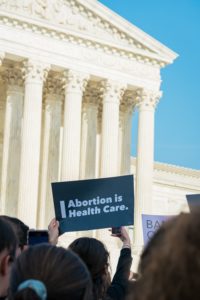
Every person has the right to bodily autonomy. Access to legal, safe, and affordable abortion is essential to health, gender and racial equity, and liberty. Last week, the United States Supreme Court’s decision to overturn Roe v. Wade ended federal protection of millions of Americans’ constitutional right to bodily autonomy and privacy. As a result, over half of states are certain or likely to ban abortion. Redstone has worked since our founding to help more people access essential health services, and we stand with people across the United States whose rights are now threatened. We will continue to serve the organizers, advocates, and community leaders who have dedicated their lives to the cause of safe, legal, and equitable access to abortion. Philanthropy and the social sector must now move swiftly and strategically to preserve that access.
ABORTION ACCESS IS AN ESSENTIAL PART OF ADVANCING EQUITY
Reproductive freedom is inextricably linked to gender, racial, and economic equity. The concept of reproductive justice articulates the need to connect reproductive rights and social justice to support and affirm the wellbeing of marginalized women of color and trans people over the full course of their lives, not just during pregnancy. As originally defined and advanced by black women, reproductive justice is the “human right to maintain personal bodily autonomy, have children, not have children, and parent the children we have in safe and sustainable communities.”
As noted by the National Health Law Program, the inability to access safe, timely, affordable, and respectful abortion care “places pregnant individuals further into poverty and harms their health as well as the wellbeing of their current and future children.” Efforts to control individuals’ reproduction are particularly perverse given histories of oppression and medical abuse of women of color, trans people, and other marginalized communities. Therefore, access to abortion is a key component of reproductive justice: people must be able to control whether, when, and how to have children.
FUNDERS AND MOVEMENT LEADERS HAVE BEEN PREPARING FOR THIS MOMENT
Efforts to chip away at Roe have been ongoing for decades. While the Supreme Court ruling is still incredibly painful in this moment and many are rightfully taking time and space to process, it is also important to recognize that funders, advocates, and service providers have been laying the groundwork to protect access in a post-Roe context. This work includes:
- Expanding methods to access abortion. Years of regulatory advocacy secured permanent Food and Drug Administration approval for patients to receive medication abortion pills by mail. Telehealth enables patients to get abortion care without visiting a clinic in-person.
- Shoring up “safe harbors” for women who can travel for care. Funders have invested in sustaining and growing service infrastructure, as well as advancing policies that expand access, in states that see patients from nearby states that restrict abortion (e.g., New Mexico has a growing number of patients from Texas). The governors of California, Oregon, and Washington announced a pact to protect patients and doctors from out-of-state criminalization laws. This work complements that of groups that pay for travel and services for people experiencing financial and logistical barriers to abortion access.
- Enshrining state constitutional rights. Eleven state supreme courts have ruled that their state constitutions protect abortion rights or access more than the federal constitution. For instance, the Center for Reproductive Rights has worked on cases to establish protection for abortion under state constitutional rights to personal autonomy, privacy, and equal protection. Vermont and California have constitutional amendments going before voters this year to explicitly protect abortion and contraception. Over the longer term, funders are investing in the pipeline of judicial candidates to better represent the majority of the public that supports the right to abortion and other gender equity issues, countering the undue influence of the anti-abortion Federalist Society.
- Preparing to defend patients and doctors. In addition to legal defense funds for people who are prosecuted for self-managed abortion, funders are supporting groups that work with law enforcement officials to understand the dangers and inequities of enforcing abortion bans, particularly for communities of color that already suffer from disparities in policing and mass incarceration. They have sought commitments to use prosecutorial discretion and prioritization of law enforcement resources to not enforce unjust bans and protect both patients and doctors.
- Supporting intersectional power-building. Over the long term, restoring, advancing, and sustaining protections for gender and reproductive equity requires a strong movement with people of color-led groups at the fore, driving what they know their communities need and want. Funders are increasingly making longer-term investments, untethered from the boom and bust of electoral cycles, in state and local partners, both directly and through intermediaries. This work is building capacity and elevating the role of reproductive justice within multi-issue coalitions.
 PHILANTHROPY MUST ADDRESS URGENT NEEDS WHILE BUILDING FOR LONG-TERM ACCESS
PHILANTHROPY MUST ADDRESS URGENT NEEDS WHILE BUILDING FOR LONG-TERM ACCESS
In response to Roe, many funders have made public commitments supporting access to reproductive healthcare. Some have invested deeply for years, while others are new to the gender and reproductive equity space or are newly speaking out on abortion specifically.
As the field rallies around this wave of public support and issue prominence, an influx of philanthropic giving from institutions and individuals, and fast-moving policy windows, funders should build on the foundation that reproductive justice organizations and movement leaders have built over decades. A group of philanthropic leaders of color offers a powerful set of recommendations for funders. They emphasize the importance of trusting those who have deep community-based experience and a clear understanding of the intersectional nature of reproductive justice.
In addition to those recommendations, this is an important moment for funders to:
- Affirm gender equity more broadly. Women are not the only people substantially impacted by restrictions on reproductive freedom. All people who can get pregnant need access to reproductive healthcare; taking a targeted universalism approach and intentionally elevating the needs of trans and nonbinary people who face additional barriers can help ensure that efforts serve both the most marginalized populations and more people overall.
- Defy and reshape the stigma around abortion. The narrative around abortion is complex. Refrains of “abortion should be safe, legal, and rare” have shifted as advocates recognize that “rare” negates the fundamental principle of bodily autonomy and misses the reality that a quarter of women have an abortion during their reproductive years. Now, opposition to abortion bans that highlight the horrifying plight of young victims of rape and incest, or people who suffer miscarriages, similarly tug at the heartstrings of those who may be uncomfortable with abortion overall; but focusing too narrowly on these cases risks stigmatizing those that get an abortion for the myriad valid reasons that are and should be their personal choice. As the immediate sting of Roe’s reversal fades, funders will do well to continue elevating the core principles of bodily autonomy, privacy, and equity and embracing the full vision of reproductive justice.
- Learn from experience and innovation across sectors. While every issue has unique nuance and every field operates differently, there is opportunity for old and new voices to both learn and teach as the funder community around reproductive issues grows. For example, today’s crisis demands immediate investment to preserve access to abortion services, but those investments are ultimately a stopgap that lacks scalable leverage. Long-term progress requires advocacy and movement building behind new policies, with the need to address tensions between groups whose visions differ (e.g., those who emphasize reproductive justice versus narrower conceptions of reproductive rights). This dynamic is similar to many other fields that must grapple with how to balance near-term preservation with long-term vision and sustainable change, such as affordable housing (preventing near-term displacement and growing longer-term housing supply) and climate change (addressing both mitigation and adaptation). Understanding how funders have made resource allocation decisions and bridged the two ends of the spectrum can help surface tactics to test and field infrastructure to build, and help philanthropy continue to hone its playbook with issue-specific adaptations.
We are heartened to see philanthropy stepping up, and we will work in solidarity with those investing urgently, creatively, inclusively, and sustainably to support reproductive and gender equity.